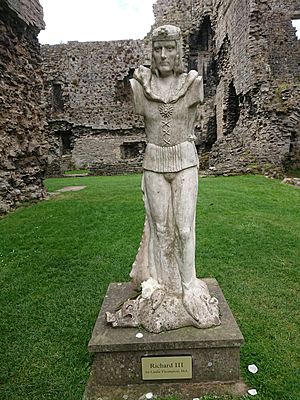Middleham Castle facts for kids
Quick facts for kids Middleham Castle |
|
|---|---|

Middleham Castle
|
|
| Coordinates | 54°17′03″N 1°48′25″W / 54.284065°N 1.806900°W |
| Site information | |
| Controlled by | English Heritage |
| Open to the public |
Yes |
| Site history | |
| Built | 1190 |
| Fate | Ruined |
Middleham Castle is a ruined castle in Middleham, a village in North Yorkshire, England. It was started in 1190 by Robert Fitzrandolph. This castle is famous for being the childhood home of King Richard III.
The castle was built to protect an important road between Richmond and Skipton. After King Richard III died, the castle stayed with the royal family. It slowly fell apart in the 1600s. Many of its stones were later used to build other structures in Middleham village.
Contents
History of Middleham Castle
Middleham Castle was built near an older castle site called William's Hill. That first castle was likely made of wood. You can still see where it stood today.
The Neville Family and the Kingmaker
In 1270, the new Middleham Castle became home to the Neville family. The most famous Neville was Richard Neville, 16th Earl of Warwick. People called him the "Kingmaker." He was a very important person during the Wars of the Roses.
Richard III's Childhood Home
After Richard, Duke of York, died in 1460, his younger son, Richard, Duke of Gloucester, came to live with Warwick. Richard grew up at Middleham Castle with Warwick's own children.
Later, Richard's brother, King Edward IV, was held prisoner at Middleham for a short time in 1469. After Warwick died in 1471, Richard married Anne Neville, Warwick's younger daughter. Middleham became their main home. Their son, Edward, was born at the castle around 1476. Sadly, he also died there in 1484.

Richard became King Richard III. However, he spent very little time at Middleham during his two years as king. After Richard died in 1485, the castle was taken by Henry VII. It remained a royal property until the time of James I, when it was sold.
The Castle Falls into Ruin
During the reign of Queen Elizabeth I, there was a plan to tear down parts of the castle. The idea was to turn it into a manor house for the Queen to use. But the castle slowly fell apart in the 1600s.
In 1644, during the Civil War, a group decided the castle was too weak to defend. They said no soldiers should be kept there. Later, some of the castle walls were even blown up. The stones were then used by people to build other buildings in Middleham.
In 1604, the castle was given to Sir Henry Linley. It was then sold to the Wood family in 1662. They owned it until 1889. Today, the castle ruins are looked after by English Heritage. They became responsible for it in 1984.
What Middleham Castle Looks Like
Middleham Castle is a large, strong building, even though it is now a ruin. Most of its walls are still standing. The castle has a simple rectangular shape. It has a huge Norman keep (the main tower) in the middle. This keep is surrounded by a later curtain wall. Later, fancy living areas were added against these walls.
The castle was built in a good spot to protect the road from Richmond to Skipton. It also guarded the area of Coverdale. Some experts believe the very first castle site was even better for defense.
The Great Keep
The main keep is like other big square keeps. But it only had two floors. Still, it is one of the largest in England. It is about 105 feet long from north to south and 78 feet wide from west to east. Inside, a wall divides both floors into two large rooms. There are towers at each corner and in the middle of each wall.
The main entrance was on the first floor, reached by a staircase. A small chapel was later built to protect this entrance. You can climb a spiral staircase to the top of the southeast tower. From there, you get great views of the town and countryside. You can even see the mound of the original castle.
The 13th-century curtain wall goes around the keep. This made the castle very strong for defense. But it was also built to be comfortable. In the 1400s, the Neville family added impressive halls and buildings against these walls. This made the castle a truly grand home for important nobles.
Bridges were built to connect these new buildings to the keep. The ceiling above the great hall was also raised. This might have been to add more light or another room.
Castle Entrance and Walls
The main way into the castle is through a tower in the northeast corner. This was also changed in the 1400s. Only the foundations are left of the original gatehouse. It used to face east into an outer area that is now gone. The gatehouse was updated in the 1300s with angled towers and an arch. There were openings in the stone to drop things on attackers.
Except for this east wall, the other walls are mostly complete. However, the walls of the living buildings are gone. Some repairs have been done to the castle in modern times. But the lower parts of the keep are very damaged. Windows and doorways have crumbled, and floors have fallen in. None of the top battlements remain. Still, Middleham Castle is an impressive ruin. You can still feel how strong and grand it once was.




